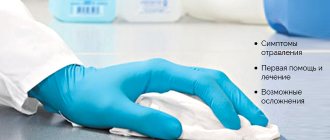is an acute circulatory failure leading to severe metabolic disorders and the development of multiple organ pathologies.
Diseases in which infectious-toxic shock develops
1. Infectious-toxic shock most often develops with infections that are accompanied by bacteremia, for example, with meningococcemia, typhoid fever
, leptospirosis.
2. At the same time, it can occur in severe cases of influenza, hemorrhagic fevers, and rickettsial infections.
3. It may be caused by some protozoa, for example, malarial plasmodia and fungi.
Causes of shock
All viral microorganisms produce toxic substances that poison the body. However, only some of them lead to shock. Most often, cases of ITS are recorded when the body is damaged by microorganisms of a protein nature. This pattern is due to 2 reasons:
- A larger surface area of the protein contains more antigens, molecules that trigger a response from the immune system;
- The protein contains several enzyme centers, each of which has a pathogenic effect on the body.
For this reason, ITS condition is most often provoked by staphylococci and streptococci. Staphylococci synthesize proteins that bind immunoglobulins and destroy collagen. Streptococci destroy blood cells, completely dissolving them.
However, it should be noted that the infectious process leading to shock also develops in other diseases. Let us list the pathological factors that cause ITS:
- Pneumonia;
- Sinusitis;
- Meningitis;
- Acute otitis media;
- Opening an abscess after injury;
- Peritonitis;
- Septic abortion;
- Tonsillitis;
- Endocarditis.
The presence of these pathologies is not a prerequisite for the development of a shock state. For pathology to occur, one of the following factors must be present:
- Great pathogenic potential of the pathogen;
- Weak immune system;
- Failure to contact medical personnel in a timely manner;
- A large amount of infectious dosage of a pathogenic agent;
- Incorrectly chosen treatment tactics.
Infections should be separated into a separate group, at the first manifestations of which toxic shock (especially in children) occurs most often. This is meningococcal disease. It is dangerous for babies at an early age. Thus, one of its subtypes (meningococcemia) causes disturbances in hemodynamics and the functioning of the adrenal glands. In this case, the symptoms and treatment will differ from the usual regimens.
It should be noted the conditions, during the development of which there is also a slight risk of developing ITS:
- Infectious complication after surgery;
- Open type injuries (wounds and burns);
- HIV;
- Postpartum sepsis;
- Intestinal infections;
- Dermatitis caused by an infectious process;
- Intravenous drug administration.
This is interesting!
Even women who regularly use tampons are susceptible to ITS. The risk is minimal, but such cases have been recorded.
Etiology
Methicillin-resistant Staphylococcus aureus
- Streptococcus pyogenes[2]
- Staphylococcus aureus[3] (especially MRSA[4])
- Salmonella typhi
- Neisseria meningitidis
== Risk Factors ==url=https://seattletimes.nwsource.com/html/health/2002160362_healthtoxicshock26.html | work=The Seattle Times | title=A new generation faces toxic shock syndrome | date=January 26, 2005}}[5][6][7]
- wounds (including burns)
- postpartum sepsis
- post-operative infections (classic signs of infection may not be present at the surgical site)
- closed wounds, such as in the nose
- sinusitis
- tracheitis
- intravenous drug use
- HIV AIDS
- allergic contact dermatitis
- There is a debate surrounding the connection with non-steroidal anti-inflammatory drugs[8]
- typhoid fever
Pathogenesis of infectious-toxic shock
ITS is based on the occurrence of a systemic inflammatory response syndrome, which is caused by the action of the structural components of bacterial cells or viruses that enter the body in large quantities.
Fragments of cell walls activate human leukocytes, resulting in the uncontrolled release of biologically active substances called cytokines. If normally cytokines play a protective role, then in ITS they are released so much that they begin to show aggression towards the host organism.
The point of application of cytokines is the vascular wall; for this reason, with ITS, all organs without exception are affected, because vessels are present everywhere. The number one target organ for sepsis is the lungs: all the body’s blood passes through them, they are a kind of filter and therefore are damaged the most. In second place are the kidneys, the organ with the highest blood supply. If the heart and blood vessels are affected, ITS occurs; this is the third most common complication of the septic process.
The main components of the pathogenesis of infectious-toxic shock
How dangerous is the pathological condition?
The consequences of infectious-toxic shock, even with high-quality treatment and the absence of complications, are quite severe. Long-term stay on a ventilator, on parenteral nutrition. The patient's prognosis is influenced by the fact of failure or disruption of the functioning of one or another organ during a state of shock.
Mortality from ITS remains high at the current stage of medical development. If the first manifestations are detected, the patient should be urgently taken to the clinic.
Shock of an infectious-toxic type is a complication, a consequence of poor-quality or independent treatment. For any bacterial diseases and no positive dynamics within 3 days, you should consult a doctor. It will protect you from possible troubles and loss of health, and in some cases, life.
The article has been approved
by the editors
Clinical picture of infectious-toxic shock
From a modern point of view, the following criteria are required to make a diagnosis of ITS:
- Confirmed or suspected infectious disease.
- A decrease in systolic blood pressure below 90 mmHg (in adults) or by more than 30% of the original level.
- Tachycardia.
- Impaired consciousness.
- Decreased diuresis (oliguria).
- Increased lactate levels in blood serum.
- Cold, pale, clammy skin.
When conducting an additional examination of the patient, other signs of sepsis can be detected, against the background of which ITS develops, namely:
- Leukocytosis with a shift to the left.
- The number of immature forms in the general blood test is more than 10%.
- Increase in ESR.
- Decreased platelet count.
- Increased CRP levels.
- Increased content of indirect bilirubin (due to liver damage).
Degrees of infectious-toxic shock
If ITS develops against the background of meningococcemia, then it has a very unique clinical picture, namely:
- Extremely rapid deterioration of the condition.
- High temperature (up to 40 0 ).
- Star-shaped hemorrhagic rash on the buttocks and extensor surfaces of the extremities, spreading to the entire torso.
- Severe tachycardia and hypotension.
- Impaired consciousness up to coma.
Diagnostics
Diagnostic measures for toxic shock syndrome are aimed at detecting the causative agent of the disease. Before performing laboratory and instrumental examinations of the patient, the doctor must carefully study the person’s medical history, determine the intensity of symptoms, and also conduct an examination. If the cause of this condition is the use of tampons, then patients are required to be examined by a gynecologist.
Other diagnostic methods include:
- conducting general and biochemical blood tests is the main way to identify the pathogen;
- measuring the amount of urine emitted per day - with such an illness, the volume of daily urine will be much less than that of a healthy person;
- instrumental examinations, which include CT, MRI, ultrasound, ECG, etc., aimed at determining the extent of damage to internal organs.
An experienced specialist can easily determine infectious-toxic shock by the patient’s appearance.
Emergency care and treatment of infectious-toxic shock
Infectious-toxic shock is an indication for emergency hospitalization of the patient. High-quality care for this disease can only be provided in the intensive care unit.
Emergency care for infectious-toxic shock and correction of hemorheological disorders
There are practically no opportunities to provide the necessary emergency care at home with ITS, so the main task when this type of shock is suspected is to quickly deliver the patient to a medical institution where there is an intensive care unit. In most cases, hospitalization in a multidisciplinary hospital is necessary; in case of suspected meningococcal infection, the patient should be routed to an infectious diseases hospital.
Emergency care for infectious-toxic shock
Patients under 18 years of age with ITS are hospitalized in children's medical institutions, over 18 years of age - in multidisciplinary hospitals.
During transportation or while waiting for emergency medical assistance to arrive, the following first aid rules must be observed:
- If a patient with ITS is unconscious, he must be placed on his side and thereby prevent the tongue from retracting.
- When seizures develop, it is necessary to prevent the patient from injury (soft fixation of the head and limbs at the time of the attack).
- At high body temperatures (over 38 C), intramuscular administration of analgin is acceptable in a dose of 2.0 ml of a 50% solution in an adult or 0.2 ml per 10 kg of body weight.
- At high temperatures, it is also possible to wipe the skin with a solution of vinegar and water in a ratio of 1:1 – 1:2.
The main task in the treatment of ITS is to maintain normal blood circulation in organs and tissues, since the main cause of death in this condition is cell damage associated with insufficient oxygen flow into them.
Criteria for diagnosing infectious-toxic shock
When diagnosing ITS, the following steps must be taken:
- Catheterization of a peripheral vein with a soft, disposable large-diameter catheter.
- Intravenous administration of polyionic solutions in a volume of approximately 20 ml per kg of body weight. The drugs of choice are Ringer's solution, Sterofundin.
- If after the administration of fluid the blood pressure has not returned to normal, the introduction of modern cardiotonic drugs is started, which enhance the force of heart contractions and help normalize blood pressure. The following drugs can be administered:
- Dopamine.
- Norepinephrine (drug of choice).
- Adrenalin.
- Mezaton.
- Dobutamine.
In the case of treatment of ITS against the background of meningococcemia, it is necessary to use large doses of glucocorticoids, since one of the most important reasons for the development of hemodynamic disorders in this form of ITS is hemorrhage into the adrenal glands and the development of acute adrenal insufficiency. In medicine, this condition is called Waterhausen-Friderichsen syndrome.
The following dosages of drugs are recommended:
| A drug | Dosage |
| Prednisolone | Initial dose – 120 mg, daily – up to 10 mg per kg |
| Dexamethasone | Initial dose – 16 mg, daily – up to 2 mg per kg |
| Methylprednisolone | 1 gram as a one-time drip for adults, children 250-500 mg |
Antibiotics should be prescribed ONLY after the elimination of closed accumulations of pus (abscess, phlegmon, peritonitis, carbuncle, etc.). Otherwise, massive death of microorganisms will be accompanied by absorption of their breakdown products into the bloodstream and deterioration of the condition. Antibacterial therapy is a key point in the treatment of sepsis and ITS. When prescribing antibiotics, the following principles should be followed:
- Treatment should begin with one or more antibiotics that have the widest possible spectrum of action against the suspected pathogen (so-called de-escalation therapy).
- When treating ITS against the background of meningococcemia, it is necessary to use chloramphenicol (chloramphenicol).
Treatment of infectious-toxic shock
The following table shows rational combinations of antibiotics depending on the suspected pathogen and the location of the primary focus.
| Antibiotic | Groups of sensitive pathogens | Features of application |
| Carbapenems (Meropenem, Imipenem, Doripenem) | Almost all known pathogens, with the exception of MRSA | Penetrate well into all organs and tissues, can be used as monotherapy for any bacterial infections |
| Protected penicillins (Amoxiclav, Augmentin) | Gram-positive cocci, gram-negative rods, anaerobes | They penetrate well into all organs and tissues. Can be used as monotherapy in patients without severe concomitant pathology |
| III-IV generation cephalosporins (Ceftriaxone, Ceftazidime, Cefoperazone, Ceftobiprole) | Gram-negative rods, gram-positive cocci | Penetrates well into various organs and tissues. To enhance the effect, combine with metronidazole |
| Second generation fluoroquinolones (Levofloxacin, Gatifloxacin) | Gram-negative rods, gram-positive cocci | Drug of choice for monotherapy of severe community-acquired pneumonia and complicated urological infections |
| III generation fluoroquinolones (Moxifloxacin) | Gram-negative rods, gram-positive cocci | Drug of choice for monotherapy of severe community-acquired pneumonia |
| Aminoglycosides (Gentamicin, Amikacin, Netilmicin) | Gram-negative rods | They penetrate well into organs and tissues, and are contraindicated for kidney disease. Must be combined with metronidazole and glycopeptides |
| Glycopeptides (Vancomycin, Teicoplanin) | Gram-positive cocci | Infections of the skin, respiratory system, bones and joints, abdominal cavity. Must be combined with cephalosporins or aminoglycosides |
Did you like the article? Save so you don't lose!
Development mechanism, reasons
The infectious process causes a number of reactions on the part of the child’s immune system and the entire body. Most bacterial pathogens are gram-negative microorganisms. They contain lipoproteins in the cell wall, which are toxic to the human body. When a bacterium dies, it is destroyed, releasing toxic compounds called endotoxins. The main pathogenetic mechanism for the development of ITS is the release of a large amount of endotoxins, followed by a pronounced reaction of the body, the accumulation of various biologically active compounds in the blood, a progressive decrease in blood pressure (hypotension), against the background of which the functional state of all organs and systems is disrupted. The likelihood of developing infectious-toxic shock increases significantly with certain infections, which include typhoid fever, chicken pox, dysentery, pneumonia, meningococcal infection, and influenza. There are several predisposing factors, against the background of which the risk of a pathological urgent state increases markedly:
- Individual characteristics of the child’s body, which usually include increased activity of the immune system, which responds to infection by producing a large number of various biologically active compounds that have a negative impact on the functional state of all organs and systems.
- Previous surgical interventions or severe injuries on the eve of an infectious pathology.
- The presence of allergic reactions, which are the result of sensitization (hypersensitivity) of the child’s body to various foreign compounds, most often of protein origin.
- Prolonged lack of treatment contributes to the accumulation of the pathogen in the child’s body. If the elevated temperature persists for 3 days, you should definitely consult a doctor. In children under one year of age, fever is an indication for immediate medical attention.
- Inappropriate therapy, in particular the use of antibacterial agents for certain infections, leads to the death of a large number of pathogenic bacteria and the corresponding release of endotoxins. For meningococcal infection, it is recommended to prescribe drugs that inhibit the growth and reproduction of meningococci, rather than killing them. This makes it possible to achieve a reduction in the number of pathogenic (disease-causing) microorganisms without the release of a significant amount of endotoxins into the blood.
Knowledge of provoking factors allows for timely therapeutic measures aimed at preventing infectious-toxic shock.
Features of treatment
Therapeutic therapy for toxic shock must be comprehensive; it must not only eliminate all manifestations of this condition, but also ensure complete cleansing of the body from toxic substances .
During therapeutic therapy, the following activities are carried out:
- the main source of infection is eliminated - all bandages, tampons, and diaphragms are removed from the vagina. If pathogenic microorganisms provoke a purulent-inflammatory process, then surgical intervention is required. During operations, the affected tissue is excised, then purulent formations are removed;
- Dopamine must be administered; hormonal agents, for example, dexamethasone, can also be used;
- antibiotic and antibacterial agents are prescribed;
- allergic reactions are eliminated with the help of special oral antihistamines;
- Doctors must eliminate oxygen deficiency. In case of complications, the patient may be connected to a mechanical ventilation system;
- To eliminate hemorheological symptoms, the patient is prescribed the use of various solutions - albumin, aminophylline, lasix. To clean the blood composition, saline solution is used;
- To reduce the symptoms of intoxication, the use of absorbents is prescribed; enterosgel has a good effect. It is imperative to provide high protection against dehydration of the body; for this you should drink special saline solutions;
- immunity increases;
- During the treatment period, the patient must be fed through a catheter . This will reduce the increased load on the digestive organs and speed up the body’s recovery process;
- If necessary, surgical cleansing of the source of infection is performed.
During the period of medical therapy, first of all, all complications must be eliminated - blood pressure is restored, organic functions are restored. To improve and strengthen the immune system, the introduction of immunoglobulin is required. After this, the main provoking factor of toxic shock is clarified. In the future, therapeutic therapy is prescribed, the action of which is aimed at eliminating the underlying disease.
In the presence of the introduction of streptococci, the acute process leads to death in almost half of the patients who are taken to the hospital. Mostly, death occurs due to serious complications of pathologies - sepsis, necrotizing fasciitis (this condition is characterized by the occurrence of a bacterial infection that completely destroys the epidermis of the skin).
How it manifests itself
Depending on the severity of the disease, there are 4 degrees of the disease - mild, moderate, severe and the development of complications. At the stage of development of complications, the decrease in the level of systemic blood pressure becomes critical, irreversible changes develop in almost all organs, and the risk of death remains very high. The development of an urgent pathological condition is indicated by several clinical symptoms:
- Increased heart rate (tachycardia).
- A decrease in blood pressure levels below the age norm.
- Development of severe headache.
- Severe muscle pain.
- Attacks of nausea followed by vomiting that are not associated with food intake.
- Periodic seizures of convulsions of striated skeletal muscles.
- Dizziness, which can reach high intensity.
- Episodic syncope in the form of short-term loss of consciousness.
With the development of respiratory, cardiac and renal failure, the child’s condition sharply worsens. If there are large amounts of toxins in the blood, a rash may appear on the skin. To reliably determine the severity of intoxication, an additional objective study is prescribed.
Varieties
There is a classification of toxic shock syndrome depending on the degree of its development. This division is based on the severity of symptoms. Thus, we distinguish:
- initial degree - in which blood pressure remains unchanged, but heart rate increases. It can reach one hundred and twenty beats per minute;
- moderate severity – characterized by progression of symptoms from the cardiovascular system. Accompanied by a decrease in systolic blood pressure and increased heart rate;
- severe degree - a significant drop in systolic tone (pressure reaches seventy millimeters of mercury). The shock index increases. Fever and a decrease in the volume of urine emitted are often observed;
- complicated stage – characterized by the development of irreversible changes in internal organs and tissues. The patient's skin takes on an earthy tint. A comatose state is often observed.
Depending on the pathogen, there are:
- streptococcal syndrome - occurs after childbirth, infection of wounds, cuts or burns of the skin, and is also a complication after infectious disorders, in particular pneumonia;
- staphylococcal toxic shock - often develops after surgery and the use of hygienic tampons;
- bacterial toxic shock - occurs due to blood poisoning and can complicate any stage of sepsis.
First aid
If you suspect the development of infectious-toxic shock in a child, it is important to seek qualified medical help as quickly as possible. Before the arrival of specialists, you should perform several simple measures that will slightly improve the child’s condition:
- Give non-steroidal anti-inflammatory drugs to reduce body temperature (paracetamol or ibuprofen in age-appropriate dosages are best for children). The temperature usually decreases 20-30 minutes after taking the medication.
- Ensure a flow of fresh air into the room, since against the background of a decrease in systemic blood pressure, it is important to ensure a sufficient supply of oxygen.
- Unbutton the collar, free from restrictive clothing, and allow the child to breathe freely.
- If possible, give hot, sweet tea to drink, which will provide the child’s body with glucose (glucose is the main energy substrate).
- Place the child on a horizontal surface, while ensuring a slight elevation of the legs (you can put a bolster under the legs). This is necessary for better blood flow to the brain in conditions of arterial hypotension.
It is not recommended to transport your child to a medical facility yourself. It is best to call an ambulance, as it is equipped with everything necessary for intensive care on the road.
Specifics of clinical manifestations
A state of infectious shock occurs as a response of the body to the structural cellular components of bacteria or viruses that have entered the blood in significant quantities. Their fragments cause leukocytes to become so activated that the body “triggers” the uncontrolled release of biologically active substances. They are called cytokines.
In a healthy person, cytokines play a protective role, helping to maintain balance in the body. However, in the case of ITS, there are so many of them that they become aggressive towards organs and systems. The point of contact between aggressors is the wall of blood vessels. And since the vasculature crosses all organs, cytokines have the opportunity to penetrate and affect each of them.
The lungs have the most unenviable position: it is through them that all blood reserves in the body are transported. Trying to “filter out” toxins, they are affected more than other organs. The kidneys take second place in terms of intoxication, followed by the heart and blood vessels.
There are several signs of infection. They are determined during a visual inspection:
- Diagnosed infectious disease.
- The main indicator of a state of shock is manifested by a decrease in blood pressure. Particular attention is paid to the systolic indicator. Its drop by 30% from normal indicators is a signal of the onset of shock.
- With elevated body temperature, there is a sore throat and aching bones.
- Tachycardia.
- Decreased amount of urination.
- The skin is cold and clammy and has a pale, almost white tint.
- The patient's consciousness is confused, frequent vomiting and fainting begin.
- The patient is in a constant state of anxiety.
- A small rash appears on the plantar parts of the feet, palms and armpits. The mucous membranes and skin become red.
- Increased pain in the infected area.
Any of these signs is a signal for immediate hospitalization. The rapid development of pathology without medical intervention will lead to death within 1-2 days.
10-12 hours after the “started” process of intoxication, the following symptoms will be added to the above symptoms:
- Blood poisoning;
- The skin on the legs and arms peels off;
- Complete death of skin cells.
Symptoms will have certain features depending on the number and degree of organ damage.
There are 4 stages of infectious-toxic shock, each of which has its own characteristics.
- Stage 1. Compensated period.
Body temperature quickly and sharply rises to 39 degrees. Increased respiration and heart rate are observed, but these indicators may return to normal for a short time. The patient feels anxious and has a headache.
- Stage 2. Development of the compensated period.
A decrease in blood pressure, and diastolic data may not be heard at all. With pronounced tachycardia, the pulse is very weak. The patient is lethargic and apathetic. The face swells and breathing becomes difficult.
Signs of circulatory failure appear: the skin becomes cold and damp, turns blue.
- Stage 3. Subcompensated period.
The person is constantly on the verge of losing consciousness. The pulse is threadlike against the background of increasing tachycardia. Blood pressure and body temperature reach critically low levels, and there is a complete absence of urine output. The skin becomes covered with spots that resemble bruises. Legs, hands and nails turn blue.
The patient's face resembles a mask, constricted pupils do not react to light. Convulsive syndrome appears.
- Stage 4. Agony
The patient is unconscious and the manifestation of convulsive syndrome increases. The skin takes on an earthy color.
The degree of infection may vary slightly depending on the cause of the pathology.
Note!
A specific manifestation of intoxication, which indicates the development of ITS, is small red dots on the body that resemble sunburn.
In children, symptoms develop faster. They almost immediately experience a sharp increase in body temperature to critical levels, vomiting and convulsions.
Classification
The basis of classification most common in medical circles is not the cause that caused ITS, but the stages of development of pathological changes in organs and tissues. Highlight:
- Reversible period of shock. It is characterized by changes in the body that affect the implementation of vital functions, but are not critical. At this stage, separate periods are distinguished: early shock, late and stable reversible state.
- Shock with irreversible critical consequences.
Reversible pathological processes of the first period are characterized by changes in blood circulation in small vessels, disturbances in tissue trophism, the occurrence of hypoxia, and the development of disseminated intravascular coagulation syndrome (DIC syndrome). The result of such reactions is a shift in the acid-base balance, which causes dysfunction of organs and systems.
The irreversible period of shock reaction is accompanied by a deepening of the changes described above. Severe disturbances of homeostasis, acidosis or alkalosis occur, and irreversible multiple organ failure develops. The result is the death of the organism.
The need for first aid
We have already mentioned that emergency care for infectious-toxic shock is provided by medical personnel in intensive care conditions, since the situation cannot be corrected without drug intervention. However, it is the patient’s relatives and friends who must recognize the development of a critical situation in time in order to seek help from professionals.
Before the arrival of specialists, you need to perform the following sequence of actions:
- Free the person from oppressive clothing;
- Ensure free air circulation in the room;
- Raise the patient's head;
- Warm his feet with heating pads;
- If the patient is conscious, give him plenty of warm water to drink;
- Regularly monitor body temperature and blood pressure, pulse and heart rate;
- In case of vomiting, make sure that the masses do not enter the esophagus, regularly cleaning the oral cavity from them;
- If convulsive syndrome is present, protect the patient from falls and bruises;
- At high temperatures, it is allowed to use antipyretic drugs;
- In the absence of vital functions, resuscitation is carried out.
It is not possible to help the patient further at the stage before hospitalization.
The actions of doctors providing emergency care for infectious-toxic shock are performed in the following sequence. After using an oxygen mask, with the help of which the patient’s body is enriched with oxygen, the administration of medications begins:
- Sodium chloride solution;
- Glucocorticoids;
- Glucose with insulin;
- Albumen;
- Eufillin.
Then the patient is urgently hospitalized, since the causes of the disease can only be identified and treatment prescribed in an inpatient setting.
Specifics of treatment tactics
After the patient is hospitalized, treatment begins before diagnostic tests are performed. This is due to the high rate of development of pathology. Therefore, diagnostics are carried out in parallel with medication prescriptions.
Therapy of infectious-toxic shock involves the use of the following medications:
- Hormones;
- Solutions of physiological and polyionic properties;
- Antibiotics.
The main condition for the treatment of ITS is the sanitation of infectious foci. If necessary, surgical intervention is used to eliminate them.
Other treatment methods are used exclusively according to indications. However, given the high probability of death, treatment is carried out only in intensive care conditions.
Preventive actions
If the developing pathology was detected on time, the prognosis for recovery is favorable. However, it is much more important to prevent such a dangerous condition. To do this, you need to follow simple rules of prevention:
- To refuse from bad habits;
- Strengthen the immune system;
- Follow all medical instructions, curing infectious diseases to the end;
- If the skin is damaged, treat the wounds with an antiseptic.
Timely seeking medical help for infectious pathologies will minimize the risk of ITS.
Complications
Quite often, people mistake the above symptoms for a cold or infection, which is why they are in no hurry to seek help from specialists. Without timely diagnosis and treatment, a number of irreversible complications of infectious-toxic shock may develop:
- impaired blood circulation, causing internal organs to not receive the proper amount of oxygen;
- acute respiratory failure – formed due to severe damage to the lungs, especially if the syndrome was provoked by pneumonia;
- impaired blood clotting and increased likelihood of blood clots, which can cause excessive hemorrhage;
- renal failure or complete failure of the functioning of this organ. In such cases, treatment will consist of lifelong dialysis or transplant surgery.
Untimely emergency care and improper therapy lead to the death of the patient within two days after the expression of the first symptoms.











